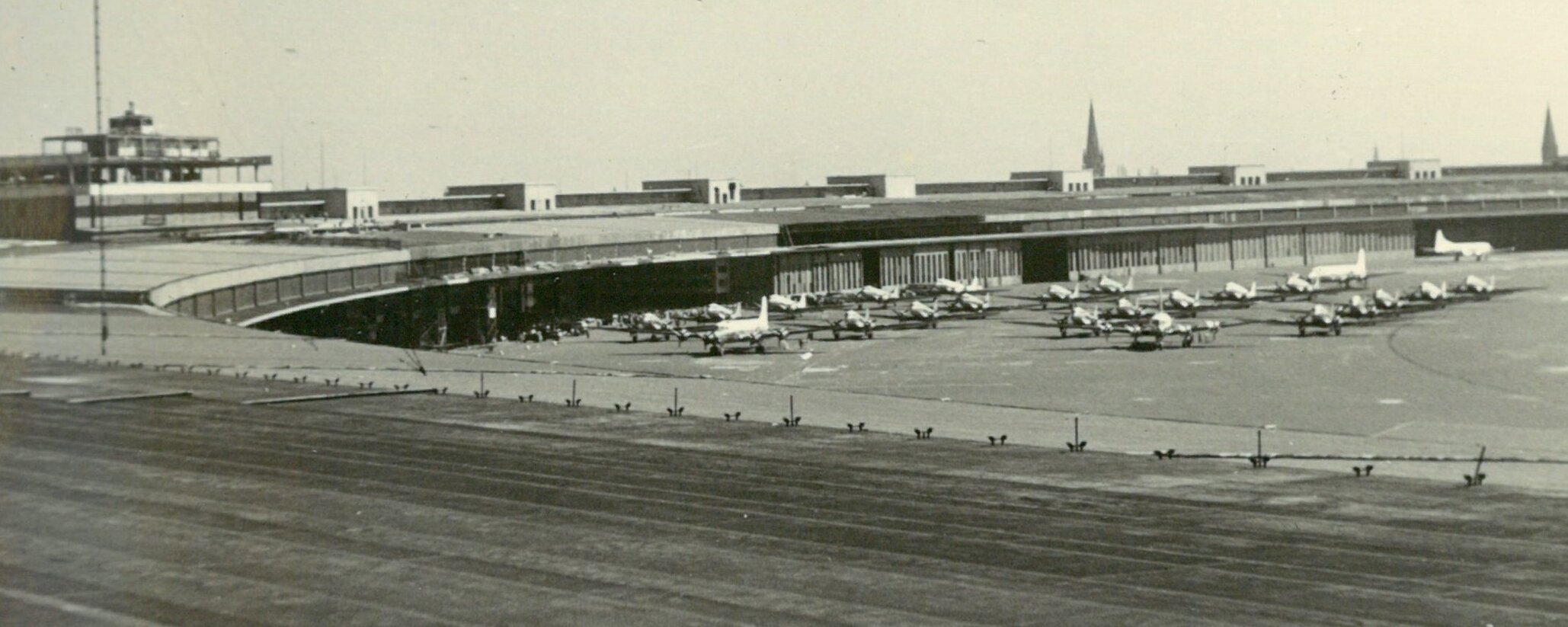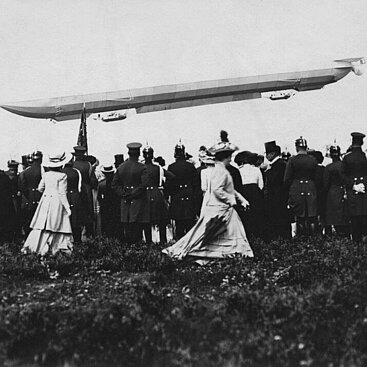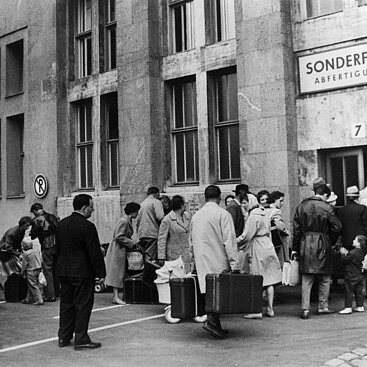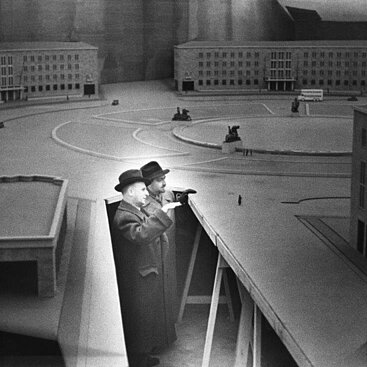| 2008 | (30 October) Closure of Airport Tempelhof | ||
| 1996 | Decision for major airport Berlin-Schönefeld | ||
| 1995 | The Airport Tempelhof is classified as a historic monument. | ||
| 1993 | Handover of the airport by US Air Force to Berliner Flughafengesellschaft | ||
| 1990 | Increase in air traffic following German Unity | ||
| 1985 | Reopening of Airport Tempelhof for business operations and companies with small aircrafts | ||
| 1975 | Commissioning of Tegel airport; Suspension of air traffic in Tempelhof | ||
| 1971-74 | Further expansion | ||
| 1971 | Peak traffic of Airport Tempelhof with approximately 5.5 million passengers in the civil part | ||
| 1962 | Commissioning of original check-in hall | ||
| 1959-62 | Reconstruction and expansion of Airport Tempelhof | ||
| 1953-57 | Children of GDR refugee families and deprived families are flown out to Federal Republic for holiday visits. | ||
| 1951 | (9 July) Resumption of civil air traffic | ||
| 1951 | Inauguration of airlift memorial by Eduard Ludwig | ||
| 1949 | (30 September) Last “airlift flight” of the US Air Force after the Soviet Union lifted the blockades on West Berlin on 12 May | ||
| 1948 | (26 June) Beginning of “airlift” as a response to imposition of blockades in West Berlin by the Soviet Union | ||
| 1948 | (23 July - 1 August) 5536 Jewish Displaced Persons flown to Frankfurt am Main in American military aircrafts from Airport Tempelhof. | ||
| 1949/50 | Beginning of departure of GDR refugees from Airport Tempelhof | ||
| 1945-93 | Airport of US Air Force | ||
| 1945 | (May - July) Airport Tempelhof under Russian command | ||
| 1945 | (25 April) End of aircraft delivery and forced labourers shortly before the take-over by Allied Forces | ||
| 1944 | Air attacks, set-up of “Stuka” production in Tempelhof | ||
| 1941 | Beginning of production of dive bombers Ju 87; Set-up of a forced labour camp | ||
| 1940 | “Weser” Flugzeugbau GmbH starts production in Tempelhof. Beginning of forced labour in airport. | ||
| 1939 | The construction work of the new airport gradually came to a halt due to the Second World War. | ||
| 1938 | Demolition of Columbia House | ||
| 1936 | Start of construction of Airport Tempelhof 1937 | (4 December) Topping-out ceremony of Airport Tempelhof and acquisition of first section of building | |
| 1935 | The architect Ernst Sagebiel received the order for the draft of a new airport. | ||
| 1934-36 | Concentration camps Columbia | ||
| 1933-34 | Gestapo prison of Columbia House (former military prison) | ||
| 1933 | (1 May) First Berlin mass arranged on 1st May after the takeover of Tempelhof field; even the rallies of the next years and other NS major events took place here. | ||
| 1929 | Renaming of Prinz-August-von-Württemberg-Straße to Columbiastraße | ||
| 1927 | Landing of ocean fliers Clarence D. Chamberlin and Charles A. Levine with their aircraft “Columbia” at first in Cottbus and then at Airport Tempelhof | ||
| 1926 | (6 January) Establishment of “Deutschen Luft Hansa AG” | ||
| 1926-29 | Construction of the main building of Airport Tempelhof; architects: Paul and Klaus Engler | ||
| 1925-28 | Construction of Neukölln sports park along the Oderstraße | ||
| 1924-25 | First phase of construction of the Airport Tempelhof hangars; architects: Heinrich Kosina and Paul Mahlberg Radio and telegraph station; architect: Fritz Bräuning | ||
| 1924 | (19 May) Establishment of “Berliner Flughafengesellschaft m.b.H.” | ||
| 1923 | (8 October) Opening of Airport Tempelhof, initially known as “Tempelhof field airport” | ||
| 1921-24 | Formation of Tempelhof field park at the north edge of the ground | ||
| 1920 | Second construction phase of Tempelhof field: Garden suburb “Tempelhof field Settlement”; Architects: Fritz Bräuning, Eduard Jobst Siedler | ||
| 1920 | (27 April) Formation of municipality of Greater Berlin; incorporation of Tempelhof After | ||
| 1909 | (23 - 27 September) Advertising flights of Hubert Latham over Tempelhof field 1910 | (31 August) Sale of an important part of the Tempelhof field by Prussian Armed Forces Treasury to the community of Tempelhof 1912-14 | First construction phase of the Tempelhof field; architect: Bruno Möhring |
| 1909 | (4 - 17 September) Orville Wright’s air shows on Tempelhof field | ||
| 1909 | (29 August) Ferdinand Graf von Zeppelin paraded through Tempelhof field with LZ 6 | ||
| 1896 | Construction of military arrest institution, later Columbia House 1897 | (12 June) Fall of the motor balloon of Hermann Wölfert over Tempelhof field (3 November) First ascent of aluminium balloon of David Schwarz from Tempelhof field; stranded in Schöneberg | |
| 1895-97 | Construction of barracks for the “Garde Kurassier Regiment” in the then Prinz-August-von-Württemberg-Straße | ||
| 1894-97 | Construction of barracks for the “Queen Augusta Garde-Grenadier Regiment No. 4” in Friesenstraße | ||
| 1893 | First scientific ascent of balloon “Humboldt” from the Tempelhof field in Schöneberg | ||
| 1888 | The B.F.C. Germania 1888, the oldest surviving football club of Germany is formed; the Tempelhof field is used as training ground; in the course of time, up to 37 football clubs trained there. | ||
| 1884 | “Balloon-Detachment” of Prussian army is formed and positioned in Schöneberg on the Tempelhof field. | ||
| 1882 | “Three Emperors Parade“ of Wilhelm I, Alexander II of Russia and Franz Joseph of Austria | ||
| 1874 | onwards, Building of barracks and other military facilities at the edge of the Tempelhof field | ||
| 1871 | (June) Victory parade after winning the Franco-Prussian War on the Tempelhof field | ||
| 1870-72 | Barrack hospital for wounded soldiers of the Franco-Prussian War of 1870/71 on the Tempelhof field | ||
| 1866 | Construction of Turkish graveyard after relocation of the previous Turkish burial ground constructed in 1798 | ||
| 1861 | Construction of garrison graveyard next to the burial ground for fall heroes of liberation wars of 1813/15 | ||
| 1830 | Horse-racing track opened on the Tempelhof field. | ||
| 1829 | Opening of amusement park “Tivoli” at the edge of the ground | ||
| 1827-1918 | Tempelhof field as parade ground of Berlin garrison | ||
| 1826/27 | Sale of Tempelhof field to the Armed Forces Treasury. | ||
| 1728 | (31 May) King Friedrich Wilhelm I and Augustus the Strong saw one of the largest parades of the 18th century on the Tempelhof field. | ||
| 1722 | The first parade of Berlin garrison is held by King Friedrich Wilhelm I, the so-called Soldier King; from then on it took place annually and was added with military exercises. | ||
| 1442 | Seizure of Tempelhof complex by Elector Frederick II. Eisenzahn; Return to Berlin and Cölln, which had to renounce their own jurisdiction for this among other things. | ||
| 1435 | The Order of Saint John sold its possession to the twin cities of Berlin/Coelln. | ||
| 1351 | (22 July) Tempelhof field was mentioned in a document for the first time: Peace agreement of Margrave Ludwig with the twin cities of Berlin/Coelln on the Tempelhof field | ||
| 1318 | After the dissolution of the Templar Order in the year 1312, the commanderies and their estates became the property of Order of Saint John. | ||
| In 1200 | Establishment of Tempelhof commanderies and colonisation of the area through Templar Order at the beginning of the 13 century |

© Bodo Koch




